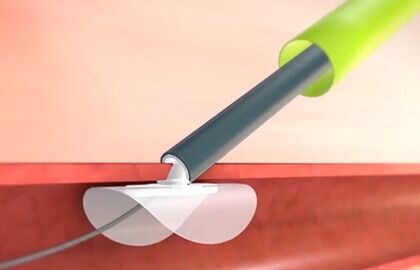Analysis of percutaneous closure device placement when choosing an ultrasound-guided vs. a fluoroscopy-guided femoral approach.
Transradial access is the access of choice in percutaneous coronary interventions, with a demonstrated benefit in mortality and bleeding when compared with transfemoral access. The latter, however, is still the access of choice in cases where large caliber introducers are used or in cases where the transradial approach is not available.

Several studies have shown that the use of percutaneous closure devices (PCD) has reduced the time to hemostasis and time to ambulation when using the transfemoral approach.
The objective of this prespecified subanalysis of the UNIVERSAL-Trial was to explore the association between vascular ultrasound (US)-guided puncture and the use of PCD in terms of bleeding and vascular complications.
This was a multicenter, open-design, randomized study, which compared US-guided puncture vs. fluoroscopy-guided puncture for PCD placement in coronary procedures. Patients <18 years of age with coronary syndrome with ST elevation or absence of palpable femoral pulse were excluded. The subjects were randomized 1:1 and US was used exclusively for the puncture, not to guide PCD placement.
The primary endpoint (PEP) was a composite of BARC type 2, 3, or 5 bleeding, or a major vascular complication (femoral pseudoaneurysm, arteriovenous fistula, retroperitoneal bleeding, hematoma >5 cm in diameter, or limb ischemia requiring intervention within 30 days).
Read also: ACC 2023 | COORDINATE-DIABETES.
A total of 621 patients were randomized and followed-up. Out of all patients, 54.7% of patients in the US group and 51% in the fluoroscopy-guided puncture group received a PCD.
Mean age was 70 years; 25.6% of subjects were female, 54.2% had a previous AMI, 39.9% had diabetes, and 54% had undergone a previous myocardial revascularization surgery. A 6Fr introducer sheath was used in 74.1% of cases; in 82% of all US-guided punctures the ANGIO-SEAL device was used. Successful common femoral cannulation was observed in 87.6% of all US-guided punctures compared with 90.4% in all non-guided punctures.
In patients who received a PCD, the US-guided approach showed a 66% reduction in the PEP (odds ratio [OR] 0.44; 95% confidence interval [CI]: 0.23-0.82), whereas in patients who did not receive a PCD, there were no significant differences (OR: 1.76; 95% CI: 0.80-4.03). The subgroup of patients in which the ANGIO-SEAL device was used experienced significantly fewer complications (OR: 0.33; 95% CI: 0.15-0.71), an effect not seen with the ProGlide device (OR: 0.74; 95% CI: 0.14-3.31).
Read also: Mechanical Aspiration in ST Elevation ACS.
The benefit of ultrasound use was at the expense of vascular complications (OR: 0.28; 95% CI: 0.10-0.71), with no differences observed in patients where PCDs were not used. There were no differences in bleeding for either group. Hematomas <5cm were 3 times more frequent when the PCD was placed without ultrasound guidance.
Conclusions
When deciding to place a percutaneous closure device in coronary procedures, ultrasound guidance of the transfemoral puncture significantly decreased vascular complications, with no changes in BARC 2, 3, or 5 type bleeding. Since this study was conducted in a subgroup, this hypothesis should be considered regarding the routine use of US for this type of device.

Dr. Omar Tupayachi.
Member of the Editorial Board of SOLACI.org.
Original Title: Ultrasound-guided femoral access in patients with vascular closure devices: a prespecified analysis of the randomised UNIVERSAL trial.
Reference: d’Entremont MA, Alrashidi S, Alansari O, et al. Ultrasound-guided femoral access in patients with vascular closure devices: a prespecified analysis of the randomised UNIVERSAL trial [published online ahead of print, 2023 Feb 25]. EuroIntervention. 2023;EIJ-D-22-01130. doi:10.4244/EIJ-D-22-01130.
Subscribe to our weekly newsletter
Get the latest scientific articles on interventional cardiology





